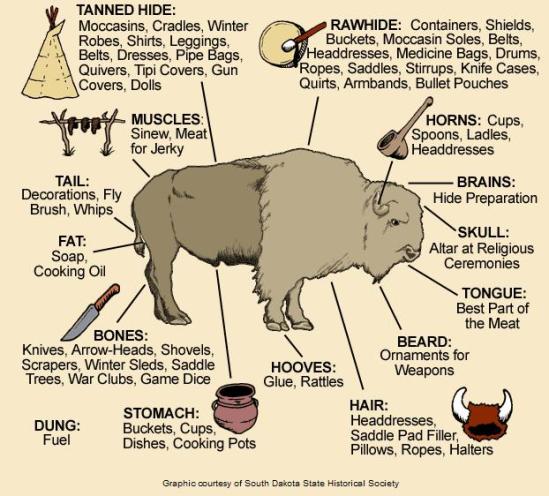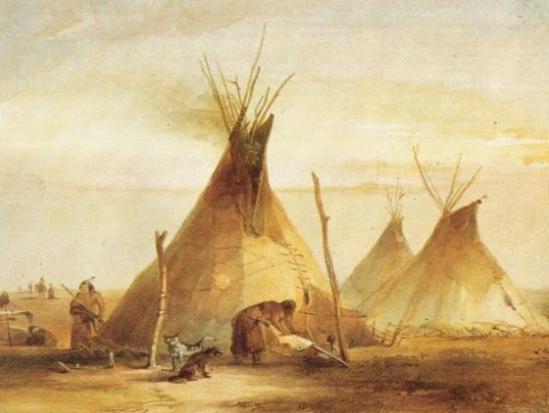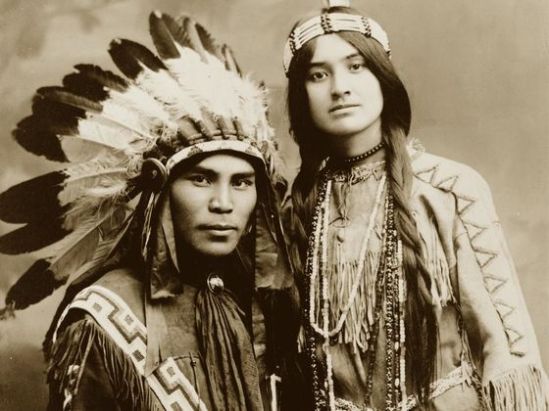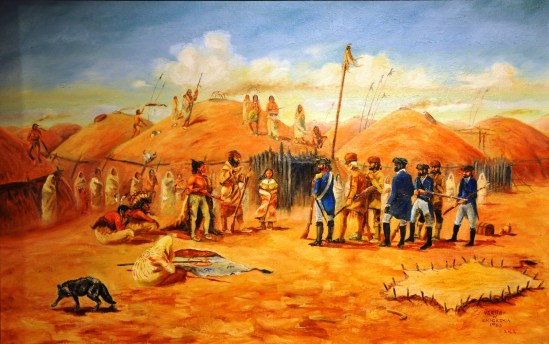
When it comes to Native Americans in popular media, no culture area is so widely recognized as those in the Great Plains. Because Plains Indians tend to be in so many western movies, so many people tend to get the wrong impression that Plains culture was the standard way of life for North American Indians in general (save for those in the Arctic).
Out of all the indigenous peoples of North America, no culture region has been depicted in popular media more than the Native Americans from the Great Plains. Stretching from south central Canada to southeastern Texas and mostly situated between the Rocky Mountains and the Mississippi River, this region has given us tribes that have forever been ingrained in the popular perception of Native Americans for good or ill. Let’s just say in western movies, you’re bound to either see a Plains Indian or a Native American dressed as one perhaps due to how widespread Plains culture was or how lazy the screenwriters were in their research. Some aspects that distinguish Plains culture are teepees, dependence on bison, chiefs wearing war bonnets, as well as horses. Plains Indians in movies may or may not use guns. However, such descriptions don’t apply to all the Plains tribes. Not to mention, the Plains tribes didn’t acquire horses via trade and/or raid networks with the Southwestern and Great Basin tribes. But once they got a hold of these animals, the Plains Indians integrated them in their daily lives, developed a reputation for their equestrian skill, and led to the origin of the mustang. The Plains Indians also traded guns with English and French fur trappers in the areas as well (though they were always in short supply so they still depended on bows and arrows). However, while these European imports improved their lives drastically as well as helped them expand territory, they came at a very high cost in the form of European diseases. Not only that, but their dependence on bison would later come back to bite them later in the 19th century with American westward expansion, the Transcontinental Railroad, the rise of the cattle industry, and Indian Wars. At this time, the US federal government set initiatives permitting bison market hunting in order to weaken the Plains Indians and pressure them to either move onto the reservations or starve. This resulted in the bison being hunted to almost extinction. Another major change since European contact was their growing importance on warfare not against whites but also among each other both as livelihood and a sport. Yet, when Plains Indians fought each other, casualties were usually light, attacks were usually ambushes and hit and runs, success was based on quantity pertaining to horses and other property, and highest military honors were for “counting coup” consisting of touching a live enemy.

The Great Plains gets its name for being mostly vat flat grassland with rolling hills and valleys. However, while some areas in this region are perfectly suitable for agriculture (such as near the Mississippi), some areas aren’t (but most of it is great for ranching making it ideal bison country). Also prone to dramatic weather events like tornadoes, blizzards, and severe thunderstorms.
Location: Between the Rocky Mountains and the Mississippi River that spans from south central Canada to southern Texas, Oklahoma, and Arkansas.
First Peoples: It’s said that the first inhabitants of this region moved there between 40,000 and 10,000 years ago. The first millennium consisted of tribes with vast trading networks and complex religious practices. But as the region grew drier and less hospitable the nomadic bands slowly followed game and water eastward until by perhaps 1200 when the area was virtually empty. However, the region gradually repopulated due to a moderation of weather conditions as well as a severe drought in the Southwest.
Environment: Mostly flat grassland with many rolling hills and valleys, though not very rugged. Summers are very hot and winters are very cold. Trees are only found by rivers and other bodies of water. Average precipitation is low though there are higher levels in the east. Dramatic weather events such as blizzards, tornadoes, and severe thunderstorms are regular occurrences.

The Plains Indians main source of survival was the buffalo which they used for everything. This diagram from the South Dakota State Historical Society illustrates which part of the animal was used for what.
Subsistence: Primarily hunter and gatherer subsistence though some practiced agriculture as well but didn’t use irrigation. Buffalo was the primary game food source which was hunted by men surrounding the animals and herding them off a cliff into confined spaces. Also hunted other animals like elk, antelope, porcupine, prairie dogs, mountain sheep, prairie chickens, eagles, cougars, wolves, beaver, bear, and deer. More agrarian tribes in the east planted crops like corn, squash, sunflowers, plums, pemmican, prairie turnip, and other wild plants. Gathered nuts, gooseberries, chokecherries, and onions. Some even fished.

Not all Plains tribes lived in teepees nor did all teepee dwelling tribes live in the Plains. However, the fact so many Plains Indians lived in these things has led many people to mistake the teepee as a standard Native American housing unit.
Housing: Mostly lived in teepees made from animal skins and poles. Each teepee could have 6-18 buffalo skins sewn together and stretched over a frame of poles. The average teepee was about 14 feet high and 14 feet in diameter and held between 5 to 8 people. Had an adjustable smoke hole at the top for ventilation. Less nomadic tribes also retained permanent earth lodges along rivers that could be square, rectangular, or beehive shaped. Each of these could hold up to 40 or more people.

The warbonnet is perhaps the most iconic Native American headdress from the Great Plains. It was a worn by men in the tribe who’ve earned a great place of respect after completing so many eagle feathers for their deeds. Such feather earning deeds might include courageous acts in battle but also political and diplomatic gains or acts that have helped the community prosper. They were also worn by the tribe’s chosen political and spiritual leaders like Chief Sitting Bull pictured here. However, expect controversy whenever you see a non-native wearing one of these as a culturally appropriated fashion accessory, which many of today’s Plains Indians consider offensive to their culture. This especially goes for sports team mascots.
Clothing: Mostly made from deer, mountain sheep, and buffalo skin. Women wore a 2-piece dress with optional sleeves. During colder weather, they wore leggings, moccasins, and buffalo robes. Men wore breechcloths and moccasins as well as a deerskin shirt, leggings, and a buffalo robe in winter. Garments decorated with fringe and quill work may reflect war honors. Wore necklaces and earrings made from bone, shell hair, or feathers, as well as tattoos. Important figures would wear elaborate feather headdresses and buffalo hats.War bonnets were sometimes worn into battle by men who’ve earned a place of great respect for the tribe as well as political and spiritual leaders.

When moving camp, Plains Indians would often load their belongings onto a wooden frame structure known as a travois. While pre-contact Plains tribes often used dogs, they would later pulled by horses by the 19th century. This picture is of a modern travois. Note the dog would’ve been attached to something much bigger and made to drag a much heavier load.
Transportation: Used a buffalo skin and pole travois sled to carry their belongings which was pulled by dogs.

Most of the nomadic Plains tribes tend to bands comprised of no more than 30 people at a time, mainly extended family members. Several hundred of these groups congregated together would form a tribe. And they only got together during the summer to hunt, trade, socialize, make war, raid, and perform religious ceremonies.
Society: Primarily nomadic though some could be semi-nomadic or sedentary all year round. Were not especially warlike (though this would change with European contact, but this is about pre-contact culture here. Also, some practiced ritualized torture). Shamans were said to have some degree of political and spiritual power. Trade was not as well developed there though there was a degree of sign language communication. The most fundamental unit was the extended family which could consist of up to 30 people. Bands and villages variable constituency were composed of up to several hundred people or related families, formed the tribe. Some of the more settled tribes also recognized clans and/or dual divisions. Bands only came together during the summer, uniting under much more centralized political leadership to hunt, socialize, trade, raid, make war, and perform religious ceremonies. During this time, camp police and other elite warrior societies kept order and punished offenders, especially during the hunt. During the winter, bands often separated back into their constituent families in the winter. Band or kin group chiefs were generally older men but the position was more of an honorific than authoritative. Open societies were age graded and could be entered by anyone of the proper age who could purchase admission. Social order was maintained by peer pressure.

While Plains women didn’t wield as much political or social power as their men, they did hold enormous power in the domestic sphere. Since Plains practiced matrilineal descent, wives owned almost all the marital property and had sole custody of the kids in a divorce that she could initiate by throwing her husband’s belongings out of the teepee. By the way, frontiersman Kit Carson’s Cheyenne wife Making Out Road divorced him this way.
Family Structure: Primarily matrilineal descent. Men hunted and fought while women tanned hides, tended crops, gathered wild foods, cooked, made clothing as well as took down and erected teepees. Women had right to divorce by throwing her husband’s things out of the teepee as well as had custody of the children as well as owned the home. Though they weren’t as engaged in public political life as the coastal tribes, women still participated in advisory roles and through women’s societies. Dead were either buried in tree scaffolds or in the ground (which they cursed before burial in case someone disturbed it, just kidding).

It’s worth noting that not all of the Great Plains tribes lived like those you’ve seen in westerns. For instance, the Mandan lived in permanent villages, built round earth houses like these, and farmed. They’re best known as one of the tribes encountered during the Lewis and Clark Expedition.
Practices: Animism, shamanism, storytelling, medicine bags, Great Spirit, vision quests, Sun Dance, dancing music, tobacco, incense burning, skin painting, stone pipes, common sign language, and beadwork.
Tools and Weapons: Spears, knives, bows and arrows, and clubs. Buffalo horn spoons and cups. Buffalo tail whips and buffalo water containers. Buffalo bone awls, hoes, and other tools. Buffalo sinew bowstrings and thread. Buffalo skull altars and buffalo hoof rattles.
Notable Tribes: Sioux, Comanche, Kiowa, Arapaho, Pawnee, Blackfoot, Cheyenne, Cree, Crow, Iowa, Kaw, Escanjaques, Mandan, Metis, Omaha, Osage, Otoe, Dakota, Lakota, Ponca, Quapaw, Nakoda, Teyas, Tonkawa, Waco, Wichita, Tsuu T’ina, Arikara, Missouria, Gros Ventre, Hidasta, Assiniboine, and Saulteaux.

